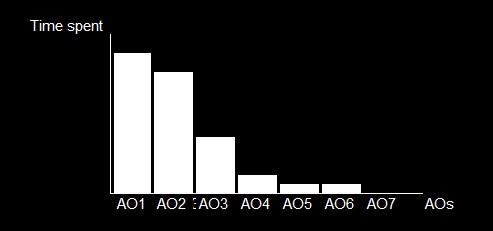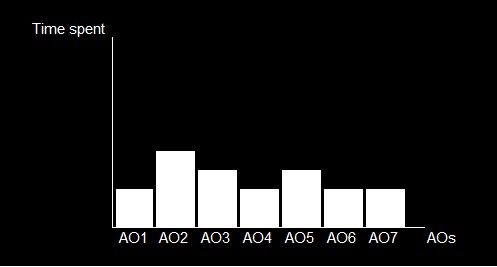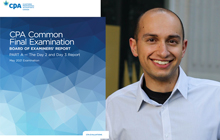How to finish CPA Program exams – including the CFE – faster

CPA program coach and mentor Gevorg Grigoryan, CPA presents time budgeting strategies and an Excel tip for writing CPA professional education program exams
TIME management is an important skill when it comes to passing any exam — including the Common Final Examination for students in the CPA professional education program. The CFE is made up of three exam days — referred to as Day 1, Day 2 and Day 3 — and each of the exam days is challenging in its own right, with a unique set of requirements and formatting.
Many aspiring chartered professional accountants say that the Day 2 is the most challenging, several claim it’s Day 3, and others say Day 1. But there is one thing we can all agree on is — finishing CPA exam cases on time is a big hurdle.
Wouldn’t you like to finish them faster? Here are some time management strategies and an Excel trick that should help.
Time Traps
When you write CPA Canada cases, you’ll see a suggested time. For example, Core 1 and Core 2 cases will always have 60 minutes, while CFE cases will have a mix of four hours, five hours and 70- to 90-minute cases. If you’re struggling to finish the cases on time, one of the reasons may be that you take this number holistically.
For example, when you start the case, you say to yourself: “Great, I have 90 minutes to finish this. Let me start with the first question.” The problem with this mindset is that you will lose track of your case time fast — very fast. I show the chart below to my students when I explain why writers fail the CPA Canada exams:
Wanting to do a good job, you invest a lot of time on the first assessment opportunity (AO). Unable to let go, you stay on this question until it’s fully done. Next AO, same ordeal. Now, 50 minutes into the case, you’re checking how many AOs you’ve completed and you realize you’re not even half-way through.
You’ve been “time trapped.” This “time trap” is a trick by case authors to test your time management skills and how well you prioritize tasks under pressure. They put the hardest question first to see whether you’ll fall for it. To help avoid this and potentially fail your CPA exam, you must learn a technique called “time budgeting.”
 |
Courtesy: Gevorg Grigoryan, CPA (CLICK TO ENLARGE.) |
Budgeting Time
To pass the CPA Canada exams, including the CFE, it’s important that you “time budget.” Time budgeting means to allocate a fixed number of minutes for each AO, like a deadline. Think of this like a marathon runner who sets pace times for each mile to ensure they finish the race in their goal time. Similarly, let’s say you’re writing a 90-minute Day 3 case and you’ve identified seven AOs. The smart approach is to take the 90 minutes and allocate it to reading-outlining-planning (ROP) and the seven AOs:
- ROP: 15 minutes
- AO#1-7: 10-15 minutes
This is a general example and I suggest allocating your time more precisely. For example, if AO#2 has a lengthy appendix, complex topic, and requires integrating other appendix information, a 15-minute allocation is reasonable. To get good at allocating times precisely, keep a timer during your practice and log how long it takes you to solve each type of AO.
During the exam, use your experience and judgment of how long it will reasonably take you to answer the AO. Use factors like the complexity of the topic, amount of information given, and overall case time available. Once the time is up, quickly conclude and move on. Don’t borrow more time from the next AOs.
Here's the same chart with proper time budgets:
 |
Courtesy: Gevorg Grigoryan, CPA (CLICK TO ENLARGE.) |
Computer vs. Paper Time Budget
You have two choices to budgeting time: paper vs. computer. On the paper, you would write down the start time, duration, and end time. For example:
- ROP: 15 minutes, 12:00-12:15pm
- AO#1 – Cash flow planning: 10 minutes, 12:15-12:25pm
- AO#2 –Revenue: 15 minutes, 12:25-12:40pm
* * *
On the computer, you would write the same information in Excel. The advantage of paper time budget is that it’s in front of you and you can cross things off as you complete them. The big disadvantage is that it’s easy to miscalculate and hard to adjust. If you get sweaty palms, you can also smudge your times and lose all track of the case. On the other hand, the computer-based time budget is faster, accurate and can be adjusted on the go. For example, half-way through the case you may realize there is a hidden AO, so you can adjust it the Excel times. For these reasons, I recommend that you use a computer-based time budget.
Excel Trick
Here’s a neat Excel trick to help you budget your time on the computer. Use the formula =TIME and here’s how it works:
- Step 1: In column A, starting from row 2, label the “Start time,” “ROP,” and the AO names.
- Step 2: In column C, enter the total case time (e.g. 90 minutes) and how many minutes you’re going to spend per AO.
- Step 3: In column B, enter the exam’s start time using a colon (e.g. 12:00 PM). Excel will automatically convert it to a time format.
- Step 4: Below the exam’s start time, put =TIME formula pointing to column C for minutes and add the cell above. The 0s in TIME formula are for the hour and seconds, always keep these 0s.
- Step 5: Drag the =TIME formula to the bottom.
- Step 6: Sum column C to check that the total matches to the cases writing time.
The result will show you the exam start time, when to finish each AO, and how many minutes you’re going to spend on each AO. And yes, the =TIME formula works in the Surpass (SecureClient) secure exam software used in the CPA Canada exams.
When you create this time budget the first time, it’ll take some trial-and-error to get it right. You should practise it often during your studies until it becomes second nature.
Conclusion
As you progress in your journey towards becoming a chartered professional accountant, you’ll learn that time budgeting is an important skill to pass your CPA exams. Using a computer-based time budgeting technique in Excel will help you track your time more accurately and adjust when necessary. Practice this time management technique and adopt it during the exam. This will help you navigate your exams more efficiently, avoiding time management pitfalls and positioning yourself for success.
Gevorg Grigoryan, CPA, is an instructor, mentor and coach to students in the CPA program. Visit Gevorg CPA to learn more and subscribe to Gevorg’s YouTube channel to access CPA program videos.








(0) Comments